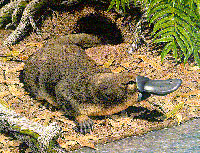|
Land animals of Australia
UNIQUE AUSTRALIAN MAMMALS
Mammals are warm-blooded and furred, and almost all give birth to their young alive and suckle them. There are three groups in the mammal family: a) monotremes b) marsupials and c) placentals. For the rest of the world, it is the placental group of mammals (eg. dogs, cats, cows, [Australian dingo], humans) which is the most commonly found.
(1) MARSUPIALS. In Australia, it is the marsupial group of mammals which is most commonly found. Young marsupials are born not fully developed, and so are kept securely in a pouch until they are strong enough to move around independently. Good examples of Australian marsupials are [kangaroos], [possums], and [wallabies].
 Australia has carnivorous (i.e. meat eating) marsupials that cannot be categorized as “cats” or “wolves”. White settlers were totally confused when they were first seen. Examples include the [Tasmanian devil] and the now extinct [Tasmanian tiger or Thylacine]. Australia has carnivorous (i.e. meat eating) marsupials that cannot be categorized as “cats” or “wolves”. White settlers were totally confused when they were first seen. Examples include the [Tasmanian devil] and the now extinct [Tasmanian tiger or Thylacine].
The herbivores (i.e. plant eating) marsupials abound and represent the cuddly postcard images of Australian wildlife. Examples are the shy, tree-dwelling [koala], the [wombat] and the many varieties of [possum] such as the ringtail and the sugar glider.
But undoubtedly, the best known are the macropods or hopping marsupials such as the [kangaroo], [wallaby], wallaroo and kangaroo rat. The familiar kangaroo profile is the greatest Australian symbol of them all.
(2) MONOTREMES. Monotremes are the most exotic type of mammals. Rather than give birth to live young, they lay eggs. However, they do suckle their young and display many other mammalian traits. The amphibious duck billed [platypus] is a monotreme, as is the [echidna] also known as the spiny anteater.
AUSTRALIAN REPTILES
Reptiles figure prominently in Aboriginal legend and diet, but the whiteman do not hold them in good regard, especially the really poisonous Australian snakes such as the [taipan], tiger snake, death adder and brown snake. Non-venomous varieties such as the carpet snake and the green tree snake are plentiful.
Lizards ranging from the tiniest of skinks to [goannas] more than 2 metres (6 ft) long proliferate in Australia. The most exotic is the frill-necked lizard, which has a frock of skin around its neck erected into a broad collar when confronted with danger. It should not be confused with the bearded dragon, named for its mane of prickly spines. Many city dwellers welcome the presence of the blue-tongued lizard in their gardens. It hunts snails and insects, and while it is not as faithful as a dog, it is cheaper to keep! At the other extreme, there is the very dangerous [saltwater crocodile] which kills many more humans each year than sharks.
|
